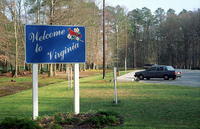Maryland and Virginia trade places
Virginia has made huge strides in smart development and transportation policies in recent years, just as Maryland has taken huge leaps in the opposite direction. Former Maryland Governor Parris Glendening gets credit for coining the term “Smart Growth”, and DC’s progressive Planning director Harriet Tregoning used to run Maryland’s Smart Growth cabinet. But today, Virginia seems to be where it’s really at on Smart Growth policies.
Fairfax supervisors are pushing to adopt of the zoning changes that would transform Tysons into a walkable, mixed-use area around future Metro stations. Meanwhile, Montgomery County seems to be trying to build a Tysons-sized “science city” out in Gaithersburg, with dim prospects at best for transit.
Virginia is also ahead of Maryland on transportation, as BeyondDC points out. Today, the Post reported a new round of transportation cuts in the Virginia budget, including the second phase of the I-66 widening (though not the first phase). But transit funding actually rose, from $2.7 billion to $2.8 billion, as many (but not all) sprawl-inducing road projects got the ax.
In fact, according to the AP, Virginia officials even want to expand intercity passenger rail from Richmond and Lynchburg to Washington, DC. Meanwhile, while Maryland could still save billions by canceling the ICC, most politicians there are keeping their heads in the sand no matter how dire their budget becomes.
Arlington has always led the region in transit-first thinking. As the rest of Northern Virginia has grown, walkable areas expanded, and traffic worsened, Virginians and their leaders are waking up to the value of transit-oriented smart growth. Maryland, on the other hand, talks a good game but its actions leave it stuck in the mud.

